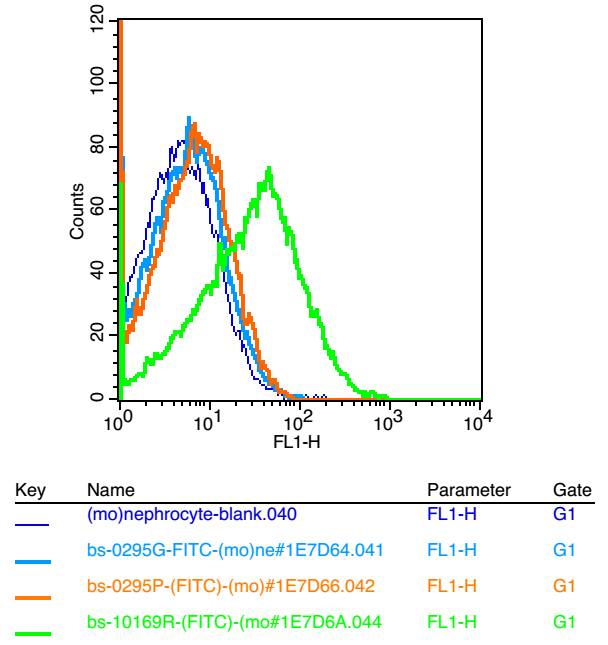
Rabbit Anti-CHRNA1 antibody
Nicotinic Acetylcholine Receptor alpha 1; Acetylcholine receptor protein alpha chain Precursor; Acetylcholine receptor subunit alpha; ACHA_HUMAN; ACHRA; CHNRA; Cholinergic receptor nicotinic alpha polypeptide 1; Cholinergic receptor, nicotinic, alpha poly
View History [Clear]
Details
Product Name CHRNA1 Chinese Name 烟碱型乙酰胆碱受体AChRα1抗体 Alias Nicotinic Acetylcholine Receptor alpha 1; Acetylcholine receptor protein alpha chain Precursor; Acetylcholine receptor subunit alpha; ACHA_HUMAN; ACHRA; CHNRA; Cholinergic receptor nicotinic alpha polypeptide 1; Cholinergic receptor, nicotinic, alpha polypeptide 1 (muscle); CHRNA1; Nicotinic cholinergic receptor alpha 1; Schizophrenia neurophysiologic defect candidate. Research Area Cell biology Neurobiology The cell membrane受体 Immunogen Species Rabbit Clonality Polyclonal React Species Mouse, (predicted: Human, Rat, Dog, Pig, Cow, Horse, Sheep, ) Applications WB=1:500-2000 ELISA=1:5000-10000 IHC-P=1:100-500 IHC-F=1:100-500 Flow-Cyt=1μg/Test ICC=1:100-500 IF=1:100-500 (Paraffin sections need antigen repair)
not yet tested in other applications.
optimal dilutions/concentrations should be determined by the end user.Theoretical molecular weight 54kDa Cellular localization The cell membrane Form Liquid Concentration 1mg/ml immunogen KLH conjugated synthetic peptide derived from human CHRNA1: 175-280/482 <Extracellular> Lsotype IgG Purification affinity purified by Protein A Buffer Solution 0.01M TBS(pH7.4) with 1% BSA, 0.03% Proclin300 and 50% Glycerol. Storage Shipped at 4℃. Store at -20 °C for one year. Avoid repeated freeze/thaw cycles. Attention This product as supplied is intended for research use only, not for use in human, therapeutic or diagnostic applications. PubMed PubMed Product Detail Members of the ligand-gated ion channel receptor family are characterized by their fast transmitting response to neurotransmitters. Two important members of this family are the nicotinic acetylcholine and glutamate receptors, both of which are composed of five homologous subunits forming a transmembrane aqueous pore. These transmembrane receptors change conformation in response to their cognate neurotransmitter. Nicotinic acetylcholine receptors (AChRs) are found at the postsynaptic membrane of the neuromuscular junction and bind acetylcholine molecules, allowing ions to move through the pore. Glutamate receptors are found in the postsynaptic membrane of cells in the central nervous system. The activity that is generated at the synapse by the binding of acetylcholine is terminated by acetylcholinesterase, an enzyme that rapidly hydrolyzes acetylcholine. AChR?, also known as ACHRD, CHRNA, CMS2A, FCCMS, SCCMS or CHRNA1, is a 482 amino acid multi-pass membrane protein that exists as two alternatively spliced isoforms, which are expressed in different tissues. Isoform 1 is only expressed in skeletal muscle whereas isoform 2 is constitutively expressed in skeletal muscle, brain, heart, kidney, liver, lung and thymus.
Function:
After binding acetylcholine, the AChR responds by an extensive change in conformation that affects all subunits and leads to opening of an ion-conducting channel across the plasma membrane.
Subunit:
Pentamer of two alpha chains, and one each of the beta, delta, and gamma (in immature muscle) or epsilon (in mature muscle) chains.
Subcellular Location:
Cell junction, synapse, postsynaptic cell membrane; Multi-pass membrane protein. Cell membrane; Multi-pass membrane protein.
Tissue Specificity:
Isoform 1 is only expressed in skeletal muscle. Isoform 2 is constitutively expressed in skeletal muscle, brain, heart, kidney, liver, lung and thymus.
DISEASE:
Defects in CHRNA1 are a cause of multiple pterygium syndrome lethal type (MUPSL) [MIM:253290]. Multiple pterygia are found infrequently in children with arthrogryposis and in fetuses with fetal akinesia syndrome. In lethal multiple pterygium syndrome there is intrauterine growth retardation, multiple pterygia, and flexion contractures causing severe arthrogryposis and fetal akinesia. Subcutaneous edema can be severe, causing fetal hydrops with cystic hygroma and lung hypoplasia. Oligohydramnios and facial anomalies are frequent.
Note=The alpha subunit is the main focus for antibody binding in myasthenia gravis. Myasthenia gravis is characterized by sporadic muscular fatigability and weakness, occurring chiefly in muscles innervated by cranial nerves, and characteristically improved by cholinesterase-inhibiting drugs.
Defects in CHRNA1 are a cause of congenital myasthenic syndrome slow-channel type (SCCMS) [MIM:601462]. SCCMS is the most common congenital myasthenic syndrome. Congenital myasthenic syndromes are characterized by muscle weakness affecting the axial and limb muscles (with hypotonia in early-onset forms), the ocular muscles (leading to ptosis and ophthalmoplegia), and the facial and bulbar musculature (affecting sucking and swallowing, and leading to dysphonia). The symptoms fluctuate and worsen with physical effort. SCCMS is caused by kinetic abnormalities of the AChR, resulting in prolonged endplate currents and prolonged AChR channel opening episodes.
Defects in CHRNA1 are a cause of congenital myasthenic syndrome fast-channel type (FCCMS) [MIM:608930]. FCCMS is a congenital myasthenic syndrome characterized by kinetic abnormalities of the AChR. In most cases, FCCMS is due to mutations that decrease activity of the AChR by slowing the rate of opening of the receptor channel, speeding the rate of closure of the channel, or decreasing the number of openings of the channel during ACh occupancy. The result is failure to achieve threshold depolarization of the endplate and consequent failure to fire an action potential.
Similarity:
Belongs to the ligand-gated ion channel (TC 1.A.9) family.
Acetylcholine receptor (TC 1.A.9.1) subfamily. Alpha-1/CHRNA1 sub-subfamily.
SWISS:
P02708
Gene ID:
1134
Database links:Entrez Gene: 1134 Human
Entrez Gene: 11435 Mouse
Omim: 100690 Human
SwissProt: P02708 Human
SwissProt: P04756 Mouse
Unigene: 434479 Human
Unigene: 4583 Mouse
Unigene: 44633 Rat
Product Picture
Isotype Control Antibody: Rabbit IgG; Dilution: 1μg in 100 μl 1 X PBS containing 0.5% BSA
Secondary Antibody: Goat anti-rabbit IgG-FITC; Dilution: 1:200 in 1 X PBS containing 0.5% BSA
Primary Antibody: rabbit Anti-CHRNA1 (SL10169R); Dilution: 1μg in 100 μl 1X PBS containing 0.5% BSA
Partial purchase records(bought amounts latest0)
No one bought this product
User Comment(Total0User Comment Num)
- No comment



 +86 571 56623320
+86 571 56623320




